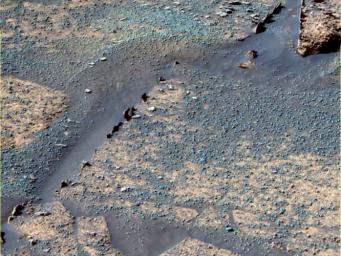
|
The ‘Razorback’ Mystery
- Click the image above for a larger view
- Full-Res JPEG (1024 x 768) (215.6 kB)
- Full-Res TIFF (1024 x 768) (2.4 MB)
Caption:
The pointy features in this image may only be a few centimeters high and less than 1 centimeter (0.4 inches) wide, but they generate major scientific interest. Dubbed "Razorback," this chunk of rock sticks up at the edge of flat rocks in "Endurance Crater." Based on their understanding of processes on Earth, scientists believe these features may have formed when fluids migrated through fractures, depositing minerals. Fracture-filling minerals would have formed veins composed of a harder material that eroded more slowly than the rock slabs.
Possible examination of these features using the instruments on NASA's Mars Exploration Rover Opportunity may further explain what these features have to do with the history of water on Mars. This false-color image was taken by the rover's panoramic camera.
Cataloging Keywords:
| Name | Value | Additional Values |
|---|---|---|
| Target | Mars | |
| System | ||
| Target Type | Planet | |
| Mission | Mars Exploration Rover (MER) | |
| Instrument Host | Opportunity (MER-B) | |
| Host Type | Rover | |
| Instrument | Panoramic Camera (Pancam) | |
| Detector | ||
| Extra Keywords | Color, Crater, Water | |
| Acquisition Date | ||
| Release Date | 2004-07-17 | |
| Date in Caption | ||
| Image Credit | NASA/JPL/Cornell | |
| Source | photojournal.jpl.nasa.gov/catalog/PIA06692 | |
| Identifier | PIA06692 | |
